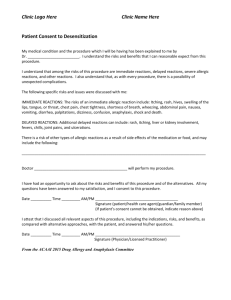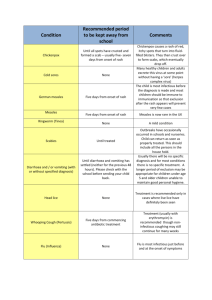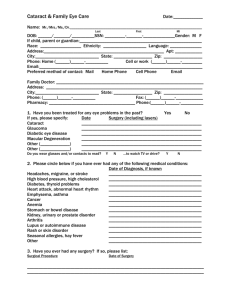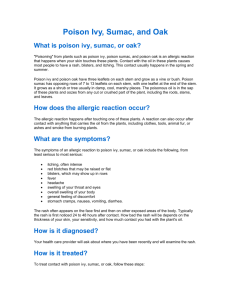Skin Allergies: Don`t Do Anything Rash
advertisement
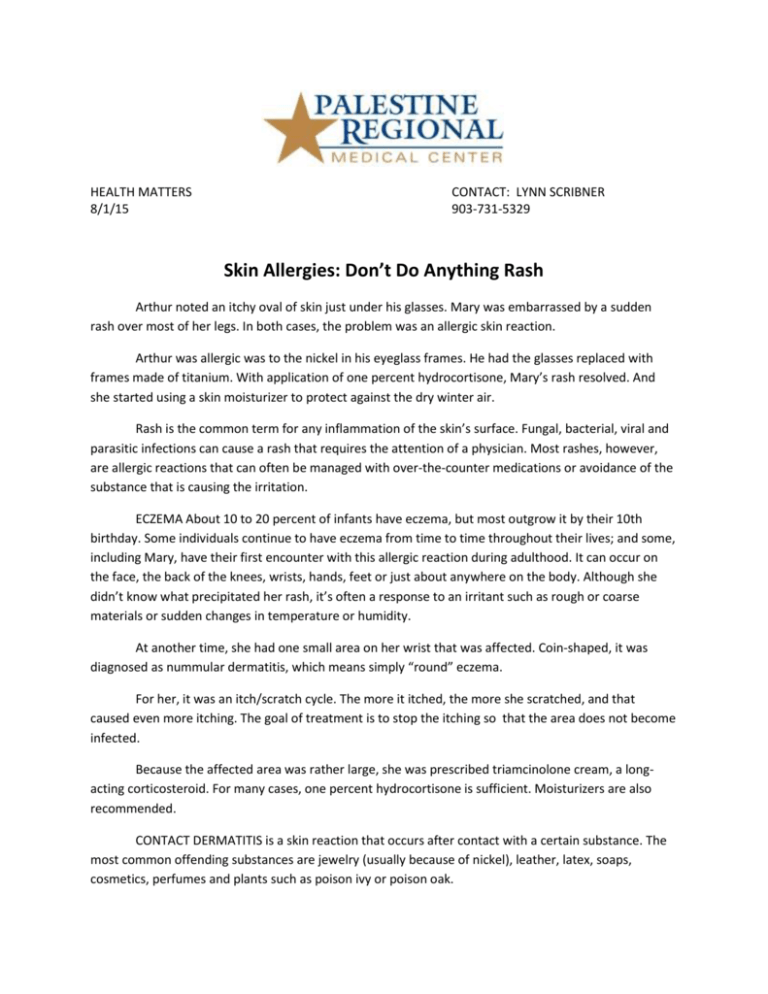
HEALTH MATTERS 8/1/15 CONTACT: LYNN SCRIBNER 903-731-5329 Skin Allergies: Don’t Do Anything Rash Arthur noted an itchy oval of skin just under his glasses. Mary was embarrassed by a sudden rash over most of her legs. In both cases, the problem was an allergic skin reaction. Arthur was allergic was to the nickel in his eyeglass frames. He had the glasses replaced with frames made of titanium. With application of one percent hydrocortisone, Mary’s rash resolved. And she started using a skin moisturizer to protect against the dry winter air. Rash is the common term for any inflammation of the skin’s surface. Fungal, bacterial, viral and parasitic infections can cause a rash that requires the attention of a physician. Most rashes, however, are allergic reactions that can often be managed with over-the-counter medications or avoidance of the substance that is causing the irritation. ECZEMA About 10 to 20 percent of infants have eczema, but most outgrow it by their 10th birthday. Some individuals continue to have eczema from time to time throughout their lives; and some, including Mary, have their first encounter with this allergic reaction during adulthood. It can occur on the face, the back of the knees, wrists, hands, feet or just about anywhere on the body. Although she didn’t know what precipitated her rash, it’s often a response to an irritant such as rough or coarse materials or sudden changes in temperature or humidity. At another time, she had one small area on her wrist that was affected. Coin-shaped, it was diagnosed as nummular dermatitis, which means simply “round” eczema. For her, it was an itch/scratch cycle. The more it itched, the more she scratched, and that caused even more itching. The goal of treatment is to stop the itching so that the area does not become infected. Because the affected area was rather large, she was prescribed triamcinolone cream, a longacting corticosteroid. For many cases, one percent hydrocortisone is sufficient. Moisturizers are also recommended. CONTACT DERMATITIS is a skin reaction that occurs after contact with a certain substance. The most common offending substances are jewelry (usually because of nickel), leather, latex, soaps, cosmetics, perfumes and plants such as poison ivy or poison oak. At first, Arthur did not suspect his glasses because he had been wearing them for more than a year. It was pretty easy, though, to identify the oval ring that circled each eye. A watchband or necklace could cause a similar reaction, either the first time it is worn or after many years of use. A reaction to poison ivy or poison oak is harder to identify since the rash can appear an hour or more after the contact occurred. If you know you have come in contact with poison ivy, wash your skin with mild soap and cool water right away. Also wash the clothes you were wearing. If the rash covers only a small area, hydrocortisone cream or calamine lotion may relieve the itching. If there are blisters, use a cold, moist compress for 30 minutes three times a day. Call your doctor if the rash is painful, keeps you awake at night or persists for 10 days or longer. In the meantime, stay clear of that plant with three small leaflets. HIVES are welts that vary in size and may connect to form even larger welts–sometimes as large as a dinner plate. They usually itch but may also sting or burn. The most common triggers are nuts, chocolate, fish, tomatoes, eggs, fresh berries, milk, food additives or medications, such as aspirin, ACE inhibitors and painkillers such as codeine. It’s sometimes difficult to find the cause. A thorough exam by your primary care physician or a dermatologist is recommended. Excess release of histamines is involved in the allergic reaction, and antihistamines are usually prescribed as part of treatment. A biologic drug, Xolair, has also been approved. HEAT RASH: Most of us have experienced heat rash at some time in our lives–red bumps on the skin with a prickly or itchy feeling. It often appears in skin creases or areas where tight clothing keeps air from circulating around the skin. Sweat glands are blocked, and the perspiration that is needed to cool the skin cannot get to the surface. The result is inflammation. Allow the skin to cool, and the rash usually fades. Babies, who lack fully developed sweat glands, are vulnerable to heat rash if they are exposed to very hot weather, are overdressed or have a fever. Since an infant can’t complain verbally, she may be fussy. If the rash doesn’t resolve when the skin cools, calamine lotion or hydrocortisone creams may help. The skin is your body’s largest organ and offers important protection from heat, cold and intruders. Allergic skin disorders are usually no cause for concern as long as they are treated promptly.

